
Tuyen Quang Province, nestled in a mountainous region of northern Vietnam, is about 125 kilometers from Hanoi. The province was a center of revolutionary activity in the past, and served as the site where key events of the anti-French August Revolution happened. Today, Tuyen Quang welcomes visitors to explore its rich history and natural surroundings.

For the best experience, travelers should plan their visit between September and the Lunar New Year. During this time, the weather is usually dry, and the landscape bursts into bloom with a diverse array of flowers.
Historical sites
Tuyen Quang has 546 historical, cultural, and scenic relics, including 435 historical sites.

The Tan Trao revolutionary base is surrounded by mountains and greenery. Photo by VnExpress/Thanh Dat
Tan Trao Commune, located in the northeast of Son Duong District, hosts 17 historical sites that played vital roles in the 9-year anti-French resistance war.
Na Lua Shack
This is where President Ho Chi Minh lived and worked from the end of May to the end of August 1945, preparing for the August Revolution.

The Na Lua Shack is a bamboo structure built in the stilt house style. Photo courtesy of Tuyen Quang’s official website
On June 4, 1945, at this location, President Ho Chi Minh held a staff meeting to plan the creation of the "Liberation Zone and Liberation Army", paving the way for the National Congress and a General Revolt. The preserved shack remains a popular tourist attraction.
Tan Trao Banyan Tree
Beneath the Tan Trao banyan tree, on the afternoon of Aug. 16, 1945, General Vo Nguyen Giap read Military Order No. 1 to launch the General Uprising. The Vietnamese Liberation Army then held a ceremony to move towards liberating the capital city of Hanoi, with participants from various ethnic groups of northern Vietnam and 60 delegates from across the country.

A stone sign at the Tan Trao banyan tree providing insight about the afternoon of Aug. 16, 1945. Photo by VnExpress/Thanh Dat
Tan Trao Communal House
This communal house in Tan Trao pays homage to the village deity Thanh Hoang, representing the traditional deities revered in communal houses throughout Vietnam, as well as the river and mountain gods of Tan Lap Village.
Constructed in 1923, it includes wooden columns, three rooms, with two sides equipped with beds for the owner and guests, all topped with a palm leaf roof. On Aug. 16, 1945, delegates at the National Congress gathered here and approved policies for a general uprising, including adopting the red flag with a yellow star as the national flag and Tien Quan Ca as the national anthem. President Ho Chi Minh also established the National Liberation Committee as a Provisional Government here.
Hong Thai Communal House
Formerly known as Kim Trien, the communal house, located in what was Kim Trien Village (now Ca village), was later renamed after activist Pham Hong Thai, who assassinated Governor-General of Indochina Martial Merlin in 1924.
Constructed in 1919, this communal house bears resemblance to the Tan Trao Communal House. It has wooden columns, three rooms, and beds on both sides for the owner and guests, all capped with a palm leaf roof.
The communal house serves as a place of worship for the village Thanh Hoang, river and mountain gods, as well as Princess Ngoc Dung, a historical figure known for her beauty, literary skills, and martial prowess. It also hosts cultural activities and village meetings.
Historically, it holds significance as the first stop for President Ho Chi Minh upon his return from Pac Bo Village, Cao Bang Province, on May 21, 1945, to lead the August Revolution.
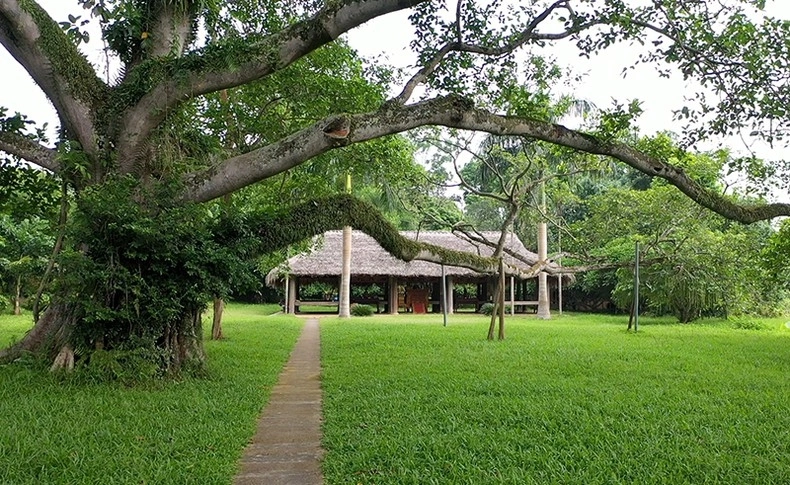
The Hong Thai Communal House is surrounded by green. Photo courtesy of MyTuyenQuang
Bong Cave
Bong Cave, situated halfway up Bong Mountain, served as the residence and workplace of President Ho Chi Minh during the resistance war against the French. It was here that President Ho Chi Minh directed the 1950 Border campaign, the first large-scale offensive campaign launched by our military in the war of resistance against French colonialists. He also directed the 2nd National Party Congress from here in 1951.
Citadel of the Mac Dynasty
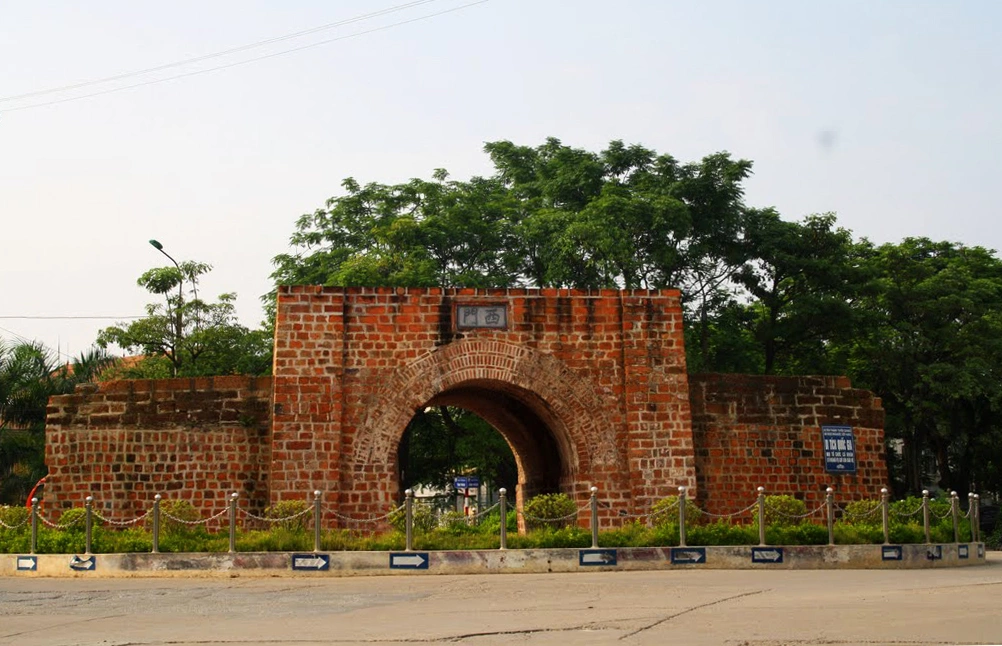
The Citadel of the Mac Dynasty features red brick construction. Photo courtesy of Tuyen Quang’s official website
Located in Tan Quang Ward, Tuyen Quang City, the Citadel of the Mac Dynasty dates back to 1592. It was later repaired during the early Nguyen Dynasty in the 19th century.
Positioned on the banks of the Lo River, the citadel played a crucial role in various historical events, including battles with the French and Japanese, and visits by President Ho Chi Minh.
While no longer fully intact, the citadel retains its fundamental elements, serving as a symbol of Tuyen Quang's history. It has recently undergone restoration and repair efforts, including the reconstruction of two city gates and 140 meters of walls.
Nguyen Tat Thanh Square

Nguyen Tat Thanh Square draws locals with its spacious and open atmosphere. Photo by VnExpress/Hung Cuong
Situated in the city center next to the Lo River, Nguyen Tat Thanh Square covers an area of over 8.5 hectares. It ranked fifth among 11 outstanding landscape projects winning the Asian Townscape Awards 2022.
At the center of Nguyen Tat Thanh Square stands the monument "Uncle Ho with all ethnic groups in Tuyen Quang Province" near the foot of Tho Son Mountain. The project was completed in 2015 on the 125th anniversary of President Ho Chi Minh’s birth.
NATURAL AND CULTURAL DESTINATIONS
Na Hang Eco-tourism Site
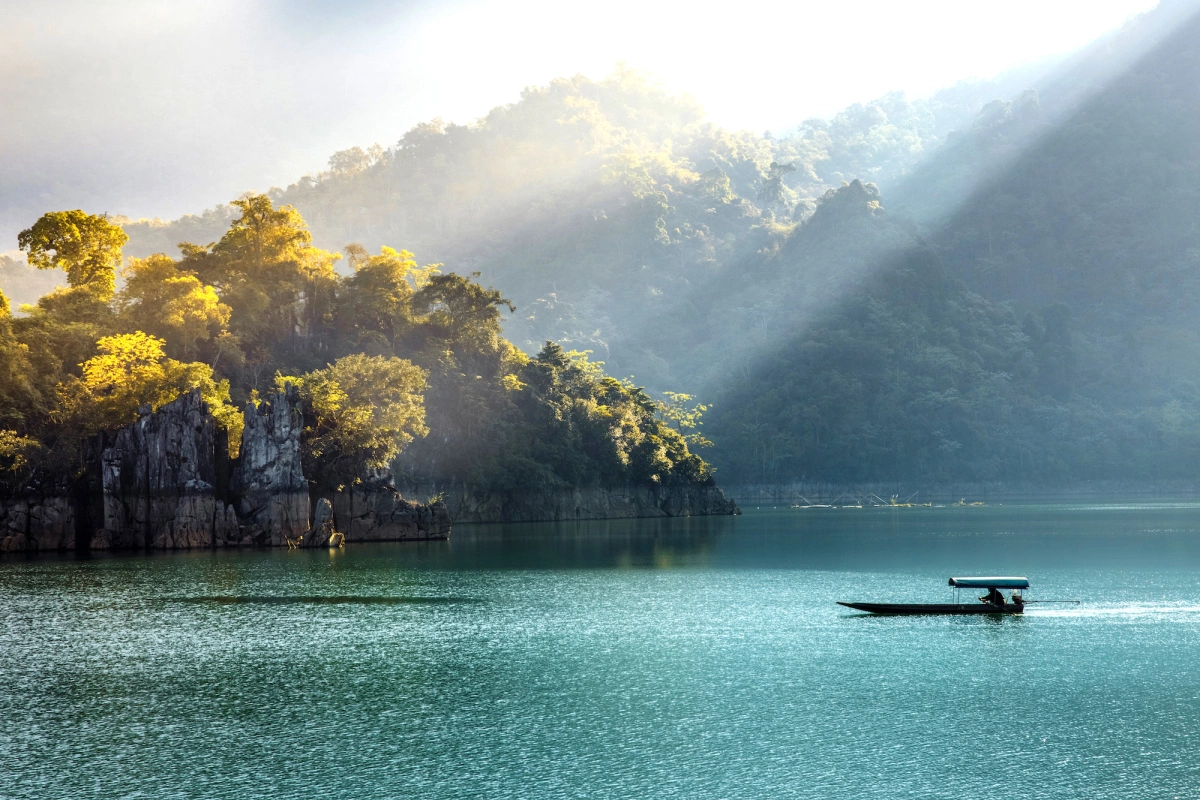
Sunrise over Na Hang Lake. Photo by Hai Le Cao
Na Hang - Lam Binh eco-tourism area lies over 100 kilometers from Tuyen Quang City. Situated at the meeting point of the Lo and Gam rivers and enveloped by limestone mountains and ancient forests, this area spans 15,000 hectares, with over 8,000 hectares covered by lakes.
Perched at an altitude exceeding 1,000 meters above sea level, Na Hang is often shrouded in fog, particularly during the winter months from November to January, making it one of the best times to visit.
Coming to Na Hang, visitors can partake in boat rides, available from 8 a.m. to 5 p.m. daily.

Vai Pha Pile is located near the Song Long Cave entrance. Photo by VnExpress/Huynh Nhi
Tourists can explore several attractions in Na Hang, including Pac Ta Temple on the district's highest mountain, the 3,000-meter-long Mo Waterfall, numerous caves, and primary forests. They also have the chance to observe langurs in their natural habitat. Trekking in the primeval jungle of Na Hang - Lam Binh nature reserve is also highly recommended.
At Na Hang Lake, visitors can find the sacred Coc Vai (Vai Pha), a 50-meter-high natural stone pillar. Tourists are encouraged to make wishes while passing by boat, as the site is considered sacred and auspicious.
The area also features other worth visiting caves such as Bo Kim Cave in Thanh Tuong Commune, Khau Quang Cave in Nang Kha Commune, Phia Muon Cave in Son Phu Commune, Khuoi Pin Cave in Khuon Ha Commune, and waterfalls like Nam Me in Khuon Ha Commune and Khuoi Nhi Waterfall in Thuong Lam Commune.
Na Hang Lake features a unique site known as the sacred Vai Pha Pile (Coc Vai), where visitors make wishes while passing by boat. Coc Vai stands 50 meters tall and is a natural stone pillar within the lake. Tourists are often encouraged by guides to make wishes for themselves or their families, as this spot is regarded as sacred and auspicious.
The area also includes several other notable caves, such as Bo Kim Cave in Thanh Tuong Commune, Khau Quang Cave in Nang Kha Commune, Phia Muon Cave in Son Phu Commune, and Khuoi Pin Cave in Khuon Ha Commune. There are also waterfalls like Nam Me in Khuon Ha Commune and Khuoi Nhi Waterfall in Thuong Lam Commune.
Na Hang Lake has a unique attraction called the Coc Vai Pile (Vai Pha), where visitors are often encouraged to make wishes for themselves or their families, as this spot is considered sacred. Coc Vai is a natural stone pillar standing 50 meters tall within the lake.
My Lam Mineral Spring
Situated 12 kilometers southwest of Tuyen Quang City, My Lam mineral spring serves as a key tourist destination in the province. Discovered by French geologists in 1923, the My Lam natural mineral water emerges clear and hot, maintaining a temperature of 67 degrees Celsius, sourced directly from underground waters over 150 meters deep.
The area has a wide range of hotels and restaurants, catering to the diverse needs of visitors.
Mo Waterfall
Mo Waterfall, also referred to as Pac Ban Waterfall, is located around 100 kilometers from Tuyen Quang City. This waterfall consists of three cascades.
There are two ways to reach Mo Waterfall. For a leisurely experience with minimal effort, visitors can opt for a boat ride. Alternatively, adventurous travelers can reach it by road. Visitors can freely explore the surrounding primeval forest. Since there are limited services, it's best to visit during daylight hours.
Ban Ba Waterfall
Ban Ba Waterfall is situated on the slopes of Phieng Khang Mountain, in Trung Ha Commune, Chiem Hoa District, approximately 70 kilometers from Tuyen Quang City. To reach the waterfall from Chiem Hoa, travelers take a road that winds 25 kilometers deep into the forest.

What sets this waterfall apart is its continuous chain of cascades, featuring three main waterfalls: Tat Cum, Tat Cao, and Tat Gio. Between these levels, smaller waterfalls with heights of 5-7 meters form a landscape with streams and pools of water.
Visitors to Ban Ba can also explore the ancient forest, home to centuries-old trees, various species of precious wood, and winding vines. At the base of the waterfall, there are green fields that provide stunning natural scenery all year round.
For those seeking a place to rest, visitors can stay at the stilt houses built by ethnic minority communities. Guests can enjoy traditional regional dishes, such as wild vegetables, grilled chicken and fish, as well as roasted pigs during their stay.
Pac Ta Temple

Pac Ta Temple stands as a spiritual sanctuary nestled at the base of Pac Ta Mountain. The temple is dedicated to and commemorates the fiancée of General Tran Nhat Duat, the sixth son of Tran Thai Tong, the first king of the Tran Dynasty.
This temple serves as a historical relic, symbolizing Vietnam's resistance against Mongol invasions in 1285. It's important to note that this site provides sightseeing opportunities only, without additional services or entertainment.
Song Long Cave
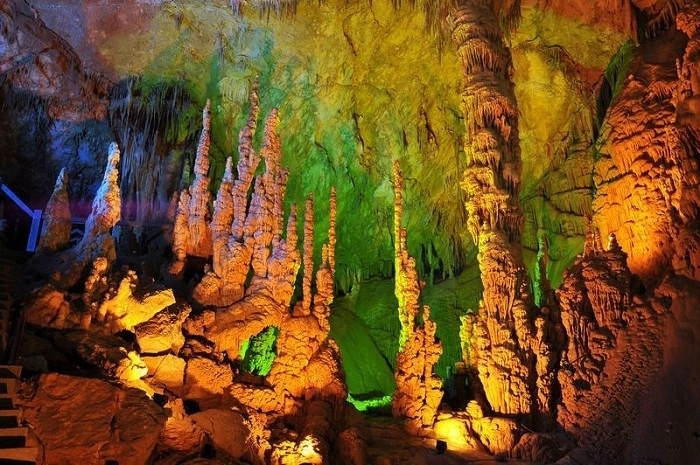
Inside Song Long Cave, colored lights have been installed. Photo courtesy of Luhanhvietnam
Located in Lam Ha Commune, Lam Binh District, Song Long Cave is a popular tourist destination attracting both domestic and international visitors. Surrounded by 99 mountains, it takes about two hours to reach the cave from Na Hang Wharf.
Sitting approximately 200 meters above the lake surface, the cave stretches over 200 meters in length, with an average height of 40 meters and a width of over 50 meters. Upon exploring Song Long Cave, visitors are greeted by the impressive stone pile at the cave entrance, known as the Vai Pha Pile.
Phia Vai Cave
Phia Vai Cave is an archaeological site situated in Lam Binh District within the Na Hang Lake area of Tuyen Quang Hydropower Plant. In 2005, evidence of primitive humans was found at Phia Vai by the Archaeology Institute and Tuyen Quang Provincial Museum.
Visitors to Phia Vai can explore artifacts and learn about the Hoa Binh cultural region. The relics found at Phia Vai Cave provide insight into the historical development of humanity.
Lo River fish salad
Upon arrival in Tuyen Quang, visitors are encouraged to sample the ca bong (spinibarbus denticulatus) fish salad. The dish offers a unique blend of flavors, combining the natural sweetness of the fish with the aromatic essence of ground fish bones, the tanginess of lemon, and the spicy kick of fresh chili.
In Tuyen Quang, the Tay ethnic group uses a traditional technique to prepare this dish. They begin by chopping fish bones and roasting them until they achieve a golden hue. These roasted bones are then finely ground and mixed with an array of spices. Thinly sliced fish is then marinated alongside the ground fish bones to create the fish salad. It is often served alongside an assortment of herbs and wild vegetables.
Steamed flowers with ground pork
Steamed hoa ke flowers (oroxylum indicum) with pork is a signature dish among the Tay people. Hoa ke resembles a small bell. This plant has a woody stem, with lots of branches, and big leaves.
After preparing the flowers by removing the pistils, they are washed and filled with a mixture of ground pork and eggs, then steamed for approximately 15 minutes. As the flowers unfurl, the meat becomes tender and subtly bitter. Served hot, it is often served with a side of fish sauce for dipping.
Na Hang black pig
The Na Hang mountain region is renowned for its black pigs, a distinct breed characterized by a long, pointed snout, shaggy hair, and a small yet robust body. These pigs are typically raised in natural environments.
The pork can be cooked in different ways like grilling with galangal and five spices, or stir-frying. The most famous is making sour pork. The sour pork dish involves massaging meat with sticky rice to aid in fermentation. Spices are added before the meat is placed in jars with corn wine, sealed to prevent air exposure. Fermentation can take 5 days to half a month, resulting in tangy meat enjoyed with sticky rice.
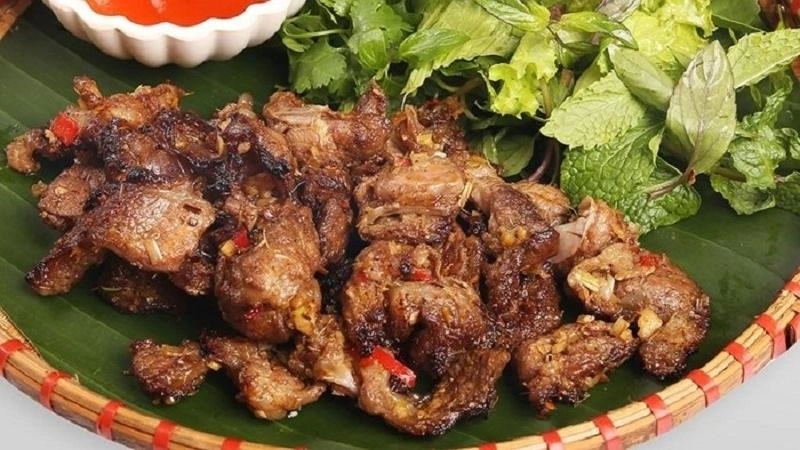
Na Hang grilled pork is served with herbs and chilli sauce to enhance the flavors. Photo courtesy of dacsantuyenquang
Sticky rice cakes filled with ant eggs
Sticky rice cakes filled with ant eggs combine the flavorful taste of sticky rice with the savory ant egg filling, enhanced by the fragrant notes of green onions and dill. Additionally, many may opt to incorporate ground pork, dried shallots, sesame seeds, or crushed roasted peanuts as fillings, along with a variety of spices.

It's important to note that some individuals may have allergies to the dish, so diners are advised to try a small portion before consuming the full serving.
Buffalo skin salad
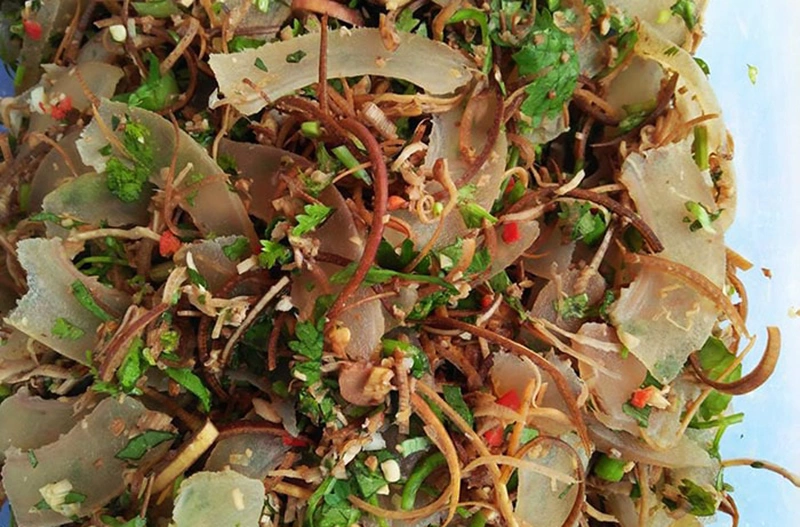
The Tay people in Lam Binh District have transformed buffalo skin into a delicacy served on special occasions. The buffalo skin is first heated over fire and then soaked in cold water. After thorough cleaning, it is boiled for one and a half to two hours before being thinly sliced. To prepare buffalo skin salad, various spices and herbs such as peanuts, coriander, sawleaf, mac khen (a peppercorn that has similar characteristics to the Sichuan pepper), and banana flowers are added.
Ham Yen oranges
Orange from Ham Yen District are big and slightly flat, which stand out for their beauty compared to oranges grown elsewhere. They're mildly sweet with a hint of sourness, making them a charming souvenir for tourists in Tuyen Quang. Visitors can also enjoy picking the fruits straight from the garden, perfect for capturing lovely photographs.
Na Hang corn wine
Upon entering a local house, visitors are greeted with the sight of a woman making this wine. The main ingredient, leaf yeast, contributes to the distinctive taste of this wine. Among the 20 herbs used for yeast production, shiitake mushrooms play a significant role in imparting a unique flavor to the wine.
The quickest route is via the Noi Bai - Lao Cai Expressway and then onto the Tuyen Quang - Phu Tho Expressway, taking approximately 2 hours for the entire journey.
The Tuyen Quang - Phu Tho Expressway is 40.2 kilometers long. It starts in Luong Vuong Commune, Tuyen Quang City, and connects to the IC9 intersection of the Noi Bai - Lao Cai Expressway.
Passenger buses from Hanoi to Tuyen Quang depart from My Dinh or Giap Bat stations, with a travel time of about 2.5 hours. Ticket prices range from VND70,000 to VND 150,000 ($2.80 to $6).
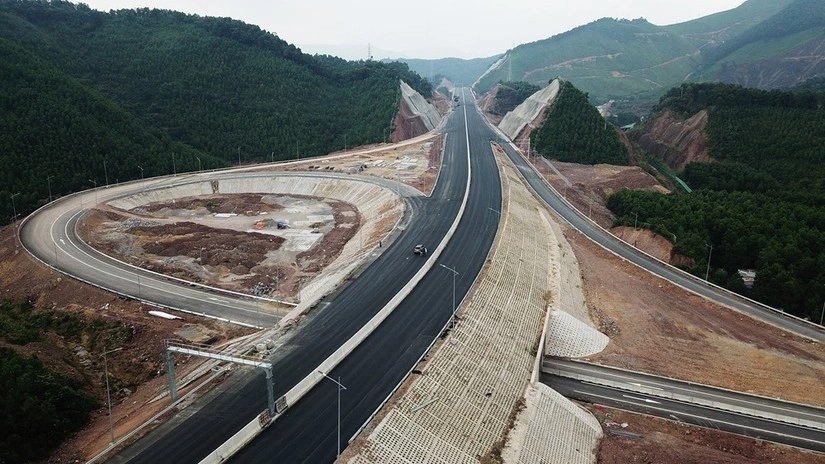
If you plan to visit destinations within 100 kilometers radius of the city center, it's more convenient to stay in the city.
Muong Thanh Tuyen Quang Hotel charges between VND1 million to VND1.3 million ($40 to $52) per night, while Royal Palace costs around VND 800,000 ($32) per night. Smaller hotels like Anh Anh Luxury Hotel, Tan Trang Hotel, Kim Long Hotel, and Nang Mai Hotel range from VND300,000 to VND600,000 per night.
The city also offers diverse options for motels and homestays such as Minh Thuy, Lan Mao, Loc Son, Hoa Hong, and Thanh Huyen, priced at VND200,000 ($8) or less per night.
In Na Hang, visitors can opt for homestays like Ban Ne Thanh Tuong, A Phu, Deo But Na Hang (Misa), Khuoi Nhi, Hung Hoa, and Hoang Viet. These places provide accommodation and dining services, with prices ranging from VND70,000 to VND150,000 ($2.80 to $6) per person per night. Tent rentals are available for about VND200,000 per night.
Tuyen Quang is abundant in hills, lakes, waterfalls, and forests, which may harbor insects. Therefore, it is recommended to bring insect repellent if you have sensitive skin to protect yourself from bug bites.
Story by Tam Anh